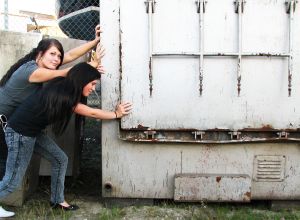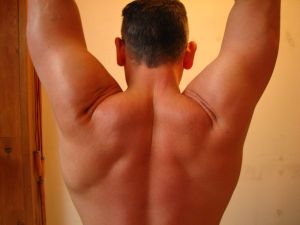Extended Arms Can Be Tough On Shoulders

The longer I work with clients in the health field, the more “tuned-in” I have become to the recurring injuries people must navigate as a function of repetitive motion.
Recently, I was talking to a Physical Therapist who shared with me an upward spike of injuries in the number of athletes she sees who play the same sport year round. This observation certainly makes sense as even athletes who play at the highest level, have an “off season” build into their training comprised of some rest.
Ironically, these off seasons are usually spent strengthening muscles that keep their joint stable and force application balanced, even or symmetrical. For the “John Q. Public” however, repetitive motion wear and tear is equally possible. Specifically, the shoulder comes to mind when evaluating the forces that subject a person to increased stress at a specific joint.
With our arms in a constant state of extension, whether it be pushing things like doors, keyboarding (which also can play a role in carpal tunnel syndrome), moving objects, driving, reading, or navigating countless daily obstacles the arms are frequently in an over-used state of extension.
This aspect of shoulder mechanics alone can easily predispose a person to injury. The shoulders joints greatest asset is its superior range of motion. This fact alone, can also serve as a deficit. Since the ligaments (tough, resilient, low stretch tissue connecting bones) that allow maximal mobility of this joint must remain lax (relaxed) to facilitate this significant range of motion, the stability of this joint is dependent on strong stabilizers – those muscles that keep the end of the upper arm bone (humerus) in place within the “cup” or shallow socket also called the glenoid cavity.
While the medical jargon reveals anatomical locations, one of the problems in fitness training is failure to strengthen the stabilizer or posterior muscles in the shoulder that are responsible for a counter (opposite) tension of the stretching that occurs with arms forward. Strengthening this muscle group helps keep the head or “knob” of the hummers bone in the “”cup” or glenoid cavity. Repeated, exertion or over-exertion with arms forward without strengthening the musculature attached to the shoulder blades can lead to this asymmetry and ultimate pain or problems.
Even the slightest forward movement of the humeral head (“knob”) in this cavity can create a spiral of impingement (“pinching”) because this knob has moved forward and is not gliding properly in the cavity it should reside. Complicating matters is that the shoulder joints architecture is not nearly as well engineered as that of the hip joint. While both might qualify as ball and socket joints, the glenoid cavity or “socket” of the shoulder is very shallow and doesn’t easily contain the head of the upper arm bone.
The Fix
There is never a guarantee to avoid shoulder injury however several exercises can help minimize the chances:
Reverse Flys – Sit on a bench or chair, with a dumbbell in each hand. Bending forward at the waist with upper torso parallel to the ground raise arms with slight bent elbows (like your flying) squeezing the muscles behind the shoulder blade to raise the weight.
One Armed Rows – While this is primarily a lat movement it utilizes the posterior shoulder as the elbow is pulled back. With a dumbbell in the right hand, place left knee and left hand on bench so that back is flat. Lower dumbbell until a full stretch occurs through lat and arm. Pull dumbbell up, keeping elbow close to side and as far back as possible.
Vertical Reverse Flys, Elastic Band – Begin by standing with an elastic band wrapped around a solid vertical object at shoulder height, holding handle in each hand. Walk far enough away so that arms are fully extend. Pull hands in opposite directions as far as possible, trying to squeeze shoulder blades together. If movement is too difficult, begin with more slack in band or use a band of a smaller diameter.
The best care of the shoulder begins by creating symmetrical strength between those muscles that bring the arms forwards and those muscles that attach to the shoulder blade to “counter-pull” for optimal stability.


